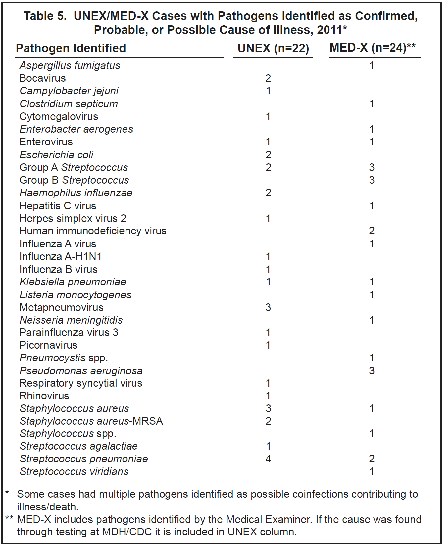Annual Summary of Disease Activity:
Disease Control Newsletter (DCN)
Related Topics
Contact Info
Unexplained Critical Illnesses and Deaths of Possible Infectious Etiology (UNEX) and Medical Examiner Infectious Deaths Surveillance (MED-X), 2011
Surveillance for unexplained critical illnesses and deaths of possible infectious etiology (UNEX) began September 1995. Focus is given to cases <50 years of age with no significant underlying conditions; however, any case should be reported regardless of the patient’s age or underlying medical conditions to determine if further testing conducted or facilitated by MDH may be indicated. In addition to provider reporting, death certificates are reviewed for any deaths in persons <50 years of age with no apparent significant underlying conditions for possible unexplained infectious syndromes.
In 2006, we began Medical Examiner Infectious Deaths Surveillance (MED-X) to evaluate all medical examiner (ME) cases for infectious related deaths. MEs report explained and unexplained cases to us. Unexplained deaths in previously healthy individuals <50 years of age are included regardless of infectious hallmarks; this primarily includes Sudden Unexplained Infant Deaths (SUIDs). In addition, we review death certificates for any case in which an autopsy was performed by an ME with a potential infectious cause of death. Cases found through death certificate review are also considered for UNEX surveillance if they are <50 years of age and have no immunocompromising conditions.
Testing of pre-mortem and postmortem specimens is conducted at the PHL and the CDC Infectious Diseases Pathology Branch (IDPB). Cases are excluded from UNEX if they are determined to be explained by providers, are not critically ill, or have no infectious disease hallmarks. There were 137 cases that met criteria for UNEX surveillance (115 deaths and 22 critical illnesses) in 2011, compared to 172 cases in 2010. Of the 137, 81 (59%) were reported by providers, 55 (40%) were found by death certificate review, and 1 (1%) was found through other reporting methods. Sixty-two (45%) cases presented with respiratory symptoms; 27 (20%) with sudden unexpected death; 14 (10%) with cardiac symptoms; 12 (9%) with neurologic symptoms; 12 (9%) with shock/sepsis; 7 (5%) with an illness that did not fit a defined syndrome; 2 (1%) with gastrointestinal illness; and 1 with a genitourinary illness. The age of cases ranged from newborn to 87 years. The median age was 9 years among 81 reported cases, and 45.5 years among 56 non-reported cases found through active surveillance. Forty-eight percent resided in the metropolitan area and 60% were male.
There were 335 MED-X cases in 2011; 108 of these also met UNEX criteria. The median age of the cases was 38 years, and 61% were male. There were 211 (63%) cases found through death certificate review. MEs reported 122 (36%) cases. The most common syndrome was pneumonia/upper respiratory infection (n=137 [41%]). Of the 335 cases, 117 (35%) were confirmed to have had an infectious cause, 130 (39%) had possible infectious causes, and 88 (26%) were non-infectious or unknown cause. Pathogens determined to be related to the cause of death are described below (Table 5).
There were 148 cases that had specimens tested at the PHL and/ or the IDPB. Thirty cases had pathogens identified as confirmed or probable cause of illness, including 22 UNEX cases (Table 5). Among 43 unexplained deaths occurring in those <50 years of age without any immunocompromising conditions, 17 (40%) were explained by UNEX testing. ME surveillance detected an additional 24 cases with pathogens identified by MEs as the cause of death (Table 5). Cases with pathogens of public health importance detected included a 33 year-old previously healthy male who died suddenly after a 1-week history of an upper respiratory infection. At autopsy he was found to have bilateral acute bronchopneumonia. We identified Group A Streptococcus from bilateral lung cultures. A 5-month old was found unresponsive and died with a history of illness and with sick contacts. PCR testing detected human metapneumovirus as the likely cause of infection. A 14 year-old previously healthy female died after history of an influenza-like illness. We detected influenza B virus and methicillin resistant Staphylococcus aureus.

- For up to date information see>> Unexplained Deaths and Critical Illnesses
- Full issue>> Annual Summary of Communicable Diseases Reported to the Minnesota Department of Health, 2011